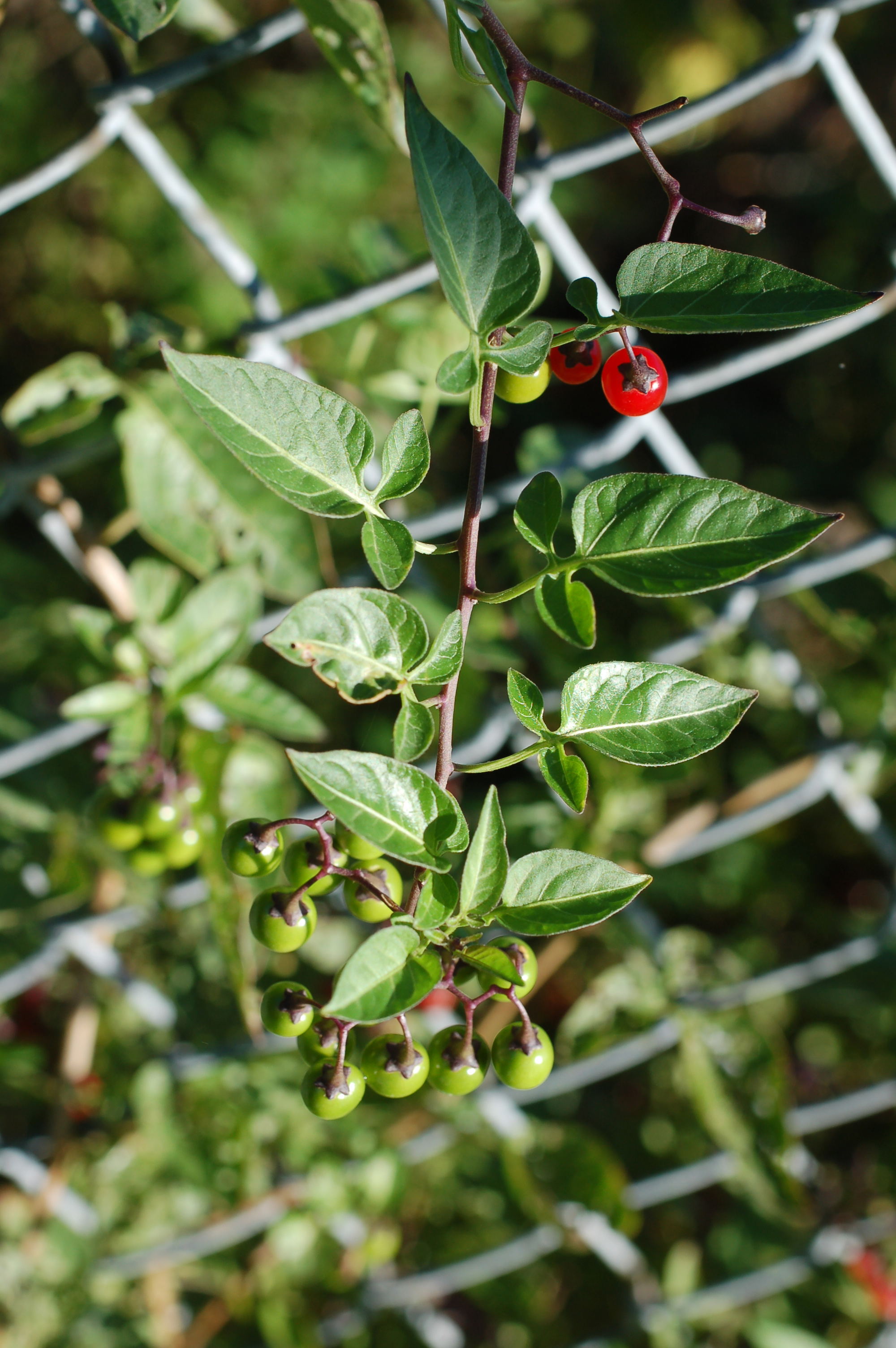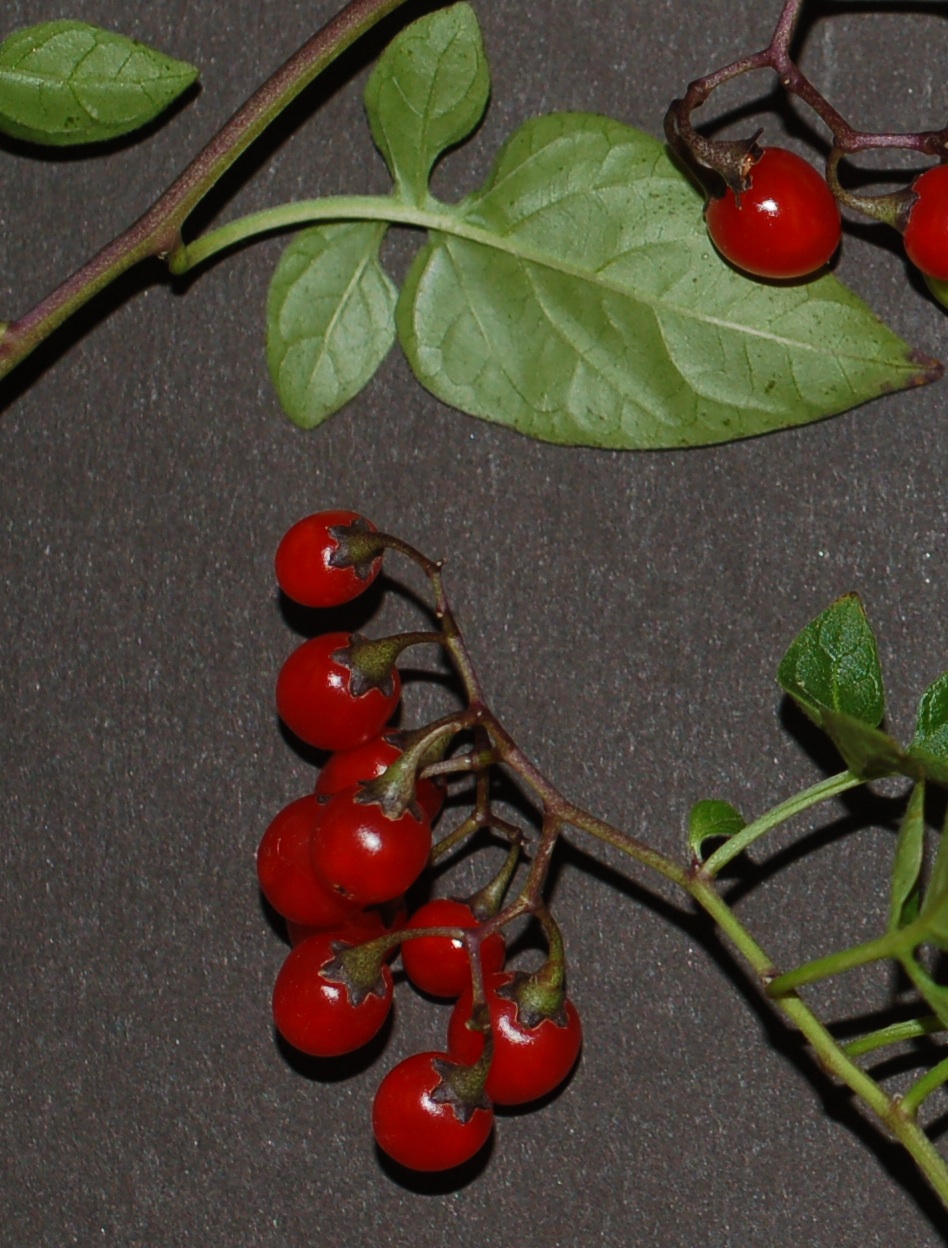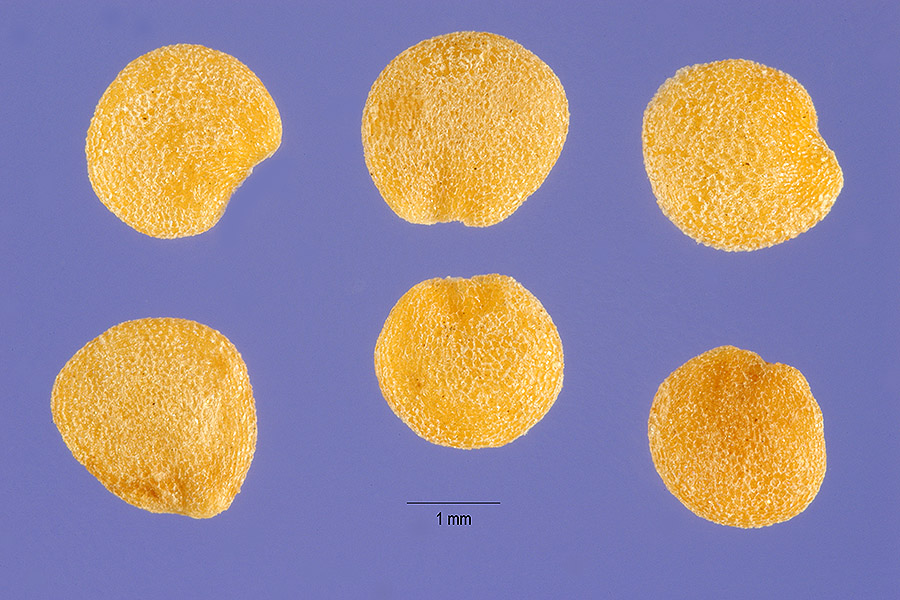 Download PDF
Download PDF
Name: Solanum dulcamara L.
Family: Solanaceae, the Potato or Nightshade Family
Common Names: Bittersweet nightshade, deadly nightshade, bittersweet (1), climbing nightshade (8), pheasant berry (9), woody nightshade (12), bitter nightshade, scarlet berry, fellenwort, poison bittersweet, dulcamara (13), blue nightshade, European bittersweet (19), dwale, fevertwig, morel, poisonberry, poisonflower, pushin-berry, skawcoo, snakeberry, tether-devil, violet-bloom, wolfgrape (20).
Etymology: The plant was coined “bittersweet” by early tasters of the plant, who said the root tasted first bitter when chewed, then sweet. The species name came thereafter from the Latin words “dulcis” and “amarus”: sweet and bitter (respectively). Solanum comes simply from the Latin name for the plant and means (literally) nightshade (1, 2, 15).
Botanical synonyms:
Solanum dulcamara var. dulcamara L.,
Solanum dulcamara var. villosissimum Desv. (1)
Quick Notable Features:
¬ bright yellow anthers, fused in a cone, strikingly apparent against the purple corolla
¬ bright, moderately large red berries
¬ dimorphic leaves that range from no basal lobing through to basal leaflets
Plant Height: The stems grow up to 7m long, but usually range between 2m and 4m (7, 10, 13).
Subspecies/varieties recognized: Solanum dulcamara var. albiflora Farw. ; Solanum dulcamara var. albiflorum House ; Solanum dulcamara var. canescens Farw. (21)
Most Likely Confused with: Lonicera spp., Echinocystis lobata, Sicyos angulatus, Physalis spp., Solanum ptycanthum.
Habitat Preference: S. dulcamara is found along fences, marshes, streams, and other disturbed areas, as well as in thickets and weedy lots. It is “abundant in swamp forests” (3). It requires moist soil, prefers low-elevation stream beds, and can tolerate mild shade (1, 3, 6, 13).
Geographic Distribution in Michigan: It is found in nearly every Michigan county with a handful of scattered exceptions in both the upper and lower peninsulas.
Known Elevational Distribution: 500-3500 meters, as reported from China (18).
Complete Geographic Distribution: Native to Eurasia and temperate northern Africa, S. dulcamara is now naturalized in most of the United States (so much so that it is actually thought to be native). It is found in every state on or north of 37º N, except Alaska and Arizona. It is also found in Georgia, Florida, and Washington DC (1, 2, 8, 13).
Vegetative Plant Description: S. dulcamara is a perennial climbing vine or shrub. The stem is hollow, green to gray-brown, and grows up to 3cm in diameter. It is unarmed. The base is woody and furrowed, and the herbaceous stems near the apex die back in the winter. The leaves are arranged “spirally” (14) (alternately) on the stem; each leaf scar bears a single bundle scar. The petioles are 2-5 cm long and minutely winged. The leaves are ovate to cordate, 7-10 cm long and 4-9 cm wide, with an acuminate tip and palmate venation. The adaxial surfaces (top) of the leaves are nearly glabrous, pubescent to glabrous underneath, and usually have two (but sometimes four or more) deep lobes at the base, although they are occasionally unlobed (usually on younger leaves). The lobes are opposite and are sometimes fully separate as leaflets. The plant produces adventitious roots (1, 2, 4, 5, 6, 9, 13, 17, 19). In the variety villosissimum, the branches and leaves are “copiously pubescent” (2).
Climbing Mechanism: Darwin wrote that Solanum dulcamara could “twine only round stems which are both thin and flexible.” He also wrote that it is “one of the feeblest and poorest of twiners,” only wrapping itself around other plants when it’s absolutely necessary. “The stem twines indifferently to the right or left” (14). He also noted it will twine around supports with a 3-4mm diameter but rarely around supports with a diameter larger than 5mm. It climbs weakly with its apical and lateral stems (pers. obs.).
Flower Description: The flower is borne on a many-flowered (10-25) cyme and has no scent. The calyx is usually 5-parted and green, purple, or brown. The corolla is also usually 5-parted with reflexed lobes; it is purple-blue to purple and occasionally white or rarely red, rotate, and 10-14mm across. The filaments are about 0.5mm long; the anthers are 4-6 mm long, connivent and form a bright yellow “beak” (1) in the middle of the flower. The style is 5.5mm long. The ovary is superior. It is usually two-loculed (1, 2, 4, 5, 9, 17, 18). “Occasionally, angular clusters of 6-12 violet flowers are produced from the stems or the axils of the leaves” (17).
Flowering Time: In Ohio, the plant flowers from mid May to early September (1), and flowers are produced in Illinois from June to October (9).
Pollinator: S. dulcamara has poricidal anthers, meaning there are tiny pores through which pollen escapes at the tip of each anther. The carpel is surrounded by a cone of fused anthers. The flower produces no nectar reward but instead offers excess pollen for larval development, and this pollen is collected by “buzz pollination”: bees grasp the anther cone and the vibration from their muscles releases the pollen (12).
Fruit Type and Description: A juicy, “attractive” (but very poisonous) red berry. It is ovoid to ellipsoid, 5-15 mm in diameter, and naked. Generally, the fruit holds about 30 seeds (1, 2, 13).
Seed Description: The seed is yellow, flat, glabrous, and mostly round, 1.5-3mm in diameter (8), see image. Our work on germination has shown that there is no dormancy requirement: the seeds sprout readily after drying in wet vermiculite (R.J. Burnham, pers. obs.).
Dispersal Syndrome: The bright red berries suggest bird-dispersal, and in fact, the plant’s first noted appearance in Ohio was on a pigeon farm (1). In Illinois, waterfowl and terrestrial mammals were observed eating the fruit as well (9). The main root suckers as a method of vegetative reproduction. It can also be grown from stem or root cuttings (13).
Distinguished by: Although its bright red berries are similar to Lonicera spp., S. dulcamara leaves are not opposite. Its dimorphic and often lobed leaves are also a good differentiating character. The entire leaf margins and lack of axillary tendrils should distinguish it from species of Echinocystis and Sicyos.
Certain species within Physalis are noted to twine, however, Physalis is known for its persistent papery calyx. Usually a vibrant red or orange, the calyx covers the berry. S. dulcamara bears bright red fleshy berries.
Although it might also be confused with Solanum ptycanthum, the latter has black berries and a stiffly upright habit. S. ptycanthum also has undulate leaf margins.

Other members of the family in Michigan: Solanum is a huge genus of over 100 species. Eight of these are found naturalized in Michigan, but because Solanum members include tomato, chili peppers, eggplant, and potato, many more are found agriculturally. The most famous of the nightshades, Atropa belladonna, is also a Solanaceae and is also found in Michigan. In addition, there are two species of Datura (jimsonweed), one species of Hyoscyamus (henbane), one species of Leucophysalis, two species of Lycium, one species of Nicotiana (tobacco), two species of Petunia (petunia), and six species of Physalis (groundcherry or chinese lantern) (8).
Ethnobotanical Uses: S. dulcamara is an extremely poisonous plant that is dangerous to ingest (and often deadly). It can, in excess, paralyze the nervous system, slow circulation, lower temperature, as well as cause vertigo, delirium, and convulsions. It has been long-used to treat warts, tumors, eruptions, and other skin diseases, however, also used for cough, diarrhea, eye infections and joint aches. It is a mild narcotic (11).
 Phylogenetic Information: Solanaceae is a member of the order Solanales, which all usually have plicate corollas and callose within their pollen. Within the order Solanales, Solanaceae is closely related to Convolvulaceae. Solanaceae has a broad global distribution that includes most climates except extreme arctic temperatures and extreme desert temperatures, and has many subfamilies (16). The Solanales, along with the Lamiales, Gentianales, and Garryales form the Euasterids I, part of the Eudicots, all of which are angiosperms.
Phylogenetic Information: Solanaceae is a member of the order Solanales, which all usually have plicate corollas and callose within their pollen. Within the order Solanales, Solanaceae is closely related to Convolvulaceae. Solanaceae has a broad global distribution that includes most climates except extreme arctic temperatures and extreme desert temperatures, and has many subfamilies (16). The Solanales, along with the Lamiales, Gentianales, and Garryales form the Euasterids I, part of the Eudicots, all of which are angiosperms.
Interesting Quotation or Other Interesting Factoid not inserted above:
-When bruised, the plant gives off an unpleasant smell (3).
-The unripe green fruits are more toxic than the ripe red ones (13).
-Solanine, the alkaloid making the plant poisonous, is found in all species of the genus (18).
Literature and websites used:
- Cooperrider, T.S. 1995. The Dicotyledons of Ohio: Linaceae Through Campanulaceae. Columbus, Ohio, USA: Ohio State University Press.
- Fernald, M. L. 1950. Gray’s Manual of Botany, 8th ed. New York, USA: American Book Company.
- Voss, E.G. 2004. Michigan Flora Part III: Dicots Concluded. Ann Arbor, Michigan, USA: University of Michigan Press.
- Radford, A.E., H.E. Ahles, and C.R. Bell. 1968. Manual of the Vascular Flora of the Carolinas. Chapel Hill, North Carolina, USA: The University of North Carolina Press.
- Hitchcock, C.L. and A. Cronquist. 1973. Flora of the Pacific Northwest. Seattle, Washington: University of Washington Press.
- Gleason, H.A. and A. Cronquist. 1991. Manual of Vascular Plants of Northeastern United States and Adjacent Canada. New York, NY: The New York Botanical Garden.
- Gleason, H.A. 1963. The New Britton and Brown Illustrated Flora of the Northeastern United States and Adjacent Canada. New York, New York, USA: Hafner Publishing Co., Inc.
- The PLANTS Database: USDA, NRCS, 1991-2007. http://plants.usda.gov/java/profile?symbol=SODU
- Iverson, L.R., D. Ketzner, and J. Karnes. 1999 – 2007. Illinois Plant Information Network: Illinois Natural History Survey and USDA Forest Service. http://www.fs.fed.us/ne/delaware/ilpin/ilpin.html.
- Tenaglia, D. Missouri Plants. Last modified: November 2006. http://www.missouriplants.com/Bluealt/Solanum_dulcamara_page.html
- Plants For A Future, 1996-2003. Last modified: June 2004. http://www.pfaf.org/database/plants.php?Solanum+dulcamara
- Glover, B.J., S. Bunnewell, and C. Martin. 2004. Convergent evolution within the genus Solanum: the specialized anther cone develops through alternative pathways. Gene 331:1-7.
- Solanum dulcamara. Francis, J.K. USDA Forest Service. www.fs.fed.us/global/iitf/pdf/shrubs/Solanum%20dulcamara.pdf
- Darwin, C. 1864. The Movement and Habit of Climbing Plants. The Linnaean Society.
- Brown, R.W. 1956. The Composition of Scientific Words. Washington, D.C., USA: Smithsonian Institution Press.
- Stevens, P. F. 2001- 2006. Angiosperm Phylogeny Website, Last modified: January 2007. http://www.mobot.org/MOBOT/research/APweb/
- Hilty, J. Illinois Wildflowers, 2002-2007. Last modified: 2006. http://www.illinoiswildflowers.info/weeds/plants/bittersweet.htm
- Flora of North America’s eFloras, 2004-2007. Last modified: 2007. http://www.efloras.org/index.aspx
- ITIS: Solanum dulcamara. 1996-2007. Last modified: 2007. http://www.itis.gov/servlet/SingleRpt/SingleRpt?search_topic=TSN&search_value=30414
- US Forest Service’s Weed of the Week: Solanum dulcamara. Last modified: July 2006. http://www.na.fs.fed.us/fhp/invasive_plants/weeds/bittersweet-nightshade.pdf
- The International Plant Names Index. Last modified: 2004. http://www.ipni.org
Image Credits (all used with permission):
1) The image of the plant’s habit is copyright Robyn J. Burnham, University of Michigan
2) The image of the flowers is copyright Robyn J. Burnham, University of Michigan
3) The image of the seedling is copyright Robyn J. Burnham, University of Michigan
4) The image of the leaves and berries is copyright Robyn J. Burnham, University of Michigan
5) The seed image is courtesy of Steve Hurst @ USDA-NRCS PLANTS Database
6) Species distribution map, derived from the Michigan Flora Online.
Primary Author: ReBecca Sonday with additions from John Bradtke and Robyn J. Burnham
© Robyn J. Burnham, University of Michigan
For additional information on Michigan Plant Diversity web pages please contact Robyn J. Burnham via email: rburnham“at”umich.edu